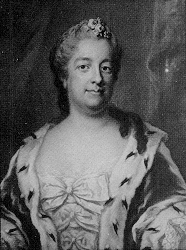Eva Ekeblad facts for kids
Quick facts for kids
Eva Ekeblad
|
|
|---|---|

Eva Ekeblad
|
|
| Born | 10 July 1724 Stockholm, Sweden
|
| Died | 15 May 1786 (aged 61) Skaraborg County, Sweden
|
| Citizenship | Swedish |
| Known for | Making flour and alcohol from potatoes (1746) |
| Awards | Membership in the Royal Swedish Academy of Sciences (1748) |
| Scientific career | |
| Fields | Agronomy |
| Influenced | Reduced hunger by making potatoes a basic food |
| Notes | |
|
First woman in the Royal Swedish Academy of Sciences: full member 1748–51, honorary member 1751–86
|
|
Eva Ekeblad (born Eva De la Gardie; 10 July 1724 – 15 May 1786) was a clever Swedish scientist and countess. She is famous for a big discovery she made in 1746. She figured out how to make flour and alcohol from potatoes. This was super important because it meant people didn't have to use valuable grains like wheat for alcohol. This helped Sweden have more food and stopped many people from going hungry. Eva Ekeblad was also the very first woman to become a member of the Royal Swedish Academy of Sciences in 1748.
Contents
Her Life
Early Life and Family
Eva De la Gardie was born in 1724. Her father was Count Magnus Julius De la Gardie. Her mother was Hedvig Catharina Lilje. In 1740, when Eva was 16, she married Count Claes Claesson Ekeblad. They had seven children together.
When she got married, Eva received two large estates, Mariedal Castle and Lindholmen Castle, Västergötland, from her father. Her husband also owned another estate and a home in Stockholm.
Managing Estates and Social Life
Because her husband was often away for work, Eva Ekeblad was in charge of managing their three large estates. This meant she had to supervise workers and handle important meetings. She was known for being strong and fair. She protected the local farmers from unfair treatment. She also made sure everything ran smoothly on her estates.
In Stockholm, Eva hosted a popular social gathering called a salon. Many important people, including artists and thinkers, visited her home. She was also friends with Queen Louisa Ulrika.
After her husband passed away in 1771, Eva moved to the countryside. She continued to manage her estates. Later, she became ill and spent her last years at Mariedal Castle. She was still admired by many people until she died in 1786.
Her Scientific Discoveries
Potatoes as a Staple Food
In 1746, Eva Ekeblad shared her amazing discoveries with the Royal Swedish Academy of Sciences. She found a way to make flour and alcohol from potatoes. Potatoes had only been grown in special gardens in Sweden before this.
Eva's work changed everything. It made potatoes a main food source for people in Sweden. This meant that grains like wheat and rye could be used more for making bread. Her discovery greatly improved how people ate and helped prevent hunger in the country.
Other Innovations
Eva Ekeblad also made other useful discoveries. In 1751, she found a way to bleach cotton fabrics using soap. The next year, in 1752, she discovered how to use potato flour in cosmetics. This was safer than the dangerous ingredients used at the time. People say she even wore potato flowers in her hair to show how useful the plant was!
First Woman in the Academy
In 1748, Eva Ekeblad made history. She became the very first woman to be chosen as a member of the Royal Swedish Academy of Sciences. This was a huge honor! However, the Academy's rules only allowed men to be full members. So, in 1751, she was referred to as an honorary member instead.
See also
 In Spanish: Eva Ekeblad para niños
In Spanish: Eva Ekeblad para niños

